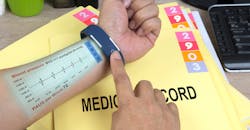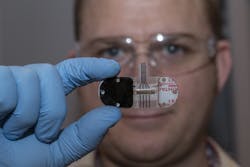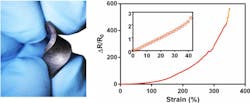Using Sweat and Skin to Create Tomorrow’s Wearable Technology
The wearable tech of today is more of a trend than a technological breakthrough. For those of us who use Fitbits and smartwatches to keep track of our steps and heartrates, the readings are more of an estimate than an accurate measurement. Due to the skin’s protective nature, it can provide biosensors with misleading data since it harbors bacteria and collects salt and other minerals found on the skin from dried sweat.
A sensor that can measure biometrics effectively must have the ability to stretch and bend as it adheres to human skin. Two focused research groups from the University of Cincinnati and the University of British Columbia are attempting to create better wearable technology by overcoming the barriers of the human skin.
Harnessing Data from Sweat
The University of Cincinnati has developed new methods to overcome the barrier of the human skin. The human skin hinders scientists’ ability to measure human vitals and biometrics. “You think of the skin as an opportunity because you can measure things through it optically, chemically, electrically, and mechanically,” said Jason Heikenfeld, assistant vice president in UC's College of Engineering and Applied Science. “But it’s actually the opposite. The body has evolved to preserve all of these chemical analytes. So, the skin actually isn’t very good at giving them up.”
Heikenfeld is the director of UC's Novel Devices Lab. He co-authored a critical review of sensor research this past February with his students and colleagues for the nanotechnology journal Lab on a Chip, outlining both scientific accomplishments to date and challenges ahead. The article discusses the growing popularity of wearable devices such as Fitbit and the Apple Watch, while also highlighting the limitations of said technology.
Novel Devices Lab’s sensor uses human sweat to obtain more accurate biometrics. The device is the size of a band-aid and is worn on the skin.
According to Heikenfeld, the latest trend of wearable tech has not been driven by breakthroughs but rather by smartphone popularity. “When you think of Fitbit, these capabilities have been around a long time,” he said. “What’s driven it is the proliferation of smartphones and miniaturization of electronics and a growing desire for health awareness.”
The secret to recording data accurately lies in human sweat. Heikenfeld is also the co-founder and chief science officer for Eccrine Systems Inc., a Cincinnati company that specializes in sweat biosensors. Eccrine Systems recently announced that it was awarded a $750,000 contract with the U.S. Air Force to study biomarkers from human sweat in real time, marking the second phase of an initial research contract with the military.
Students Adam Hauke and Phillip Simmers of the Novel Devices Lab are using human sweat to obtain more accurate biometrics. The device is the size of a Band-Aid and is worn on the skin. This next generation of sensors simulate the human body to sweat on the tiny patch of skin underneath the sensor, even when the subject is at rest. The device also measures the galvanic skin response, which indicates how much someone is sweating. The Society for Chemistry and Micro-Nano Systems recognized Hauke and Simmers with its Young Researcher Award last year for their work in continuous sweat sampling and sensing.
Laura Stegner and Amy Drexelius, another student at the Novel Devices Lab, worked on a device that can separate and concentrate the analytes in sweat or in blood. They used milling machines to customize flow-rate sensors. This can prove beneficial in filtering out the number of particles and chemicals found in our bodies from sources such as normal drinking water.
According to UC engineering student Andrew Jajack, the real value of wearable tech comes from using single-moment-in-time markers to capture real-time data. “The promise of wearable sensors is real-time health monitoring,” he said. “You can see a more complex picture of what’s going on in the body. That alone will lead to more diagnostic techniques across a spectrum of diseases.”
Sensors That Stretch
The other side of the problem is tackling sensors that can move with human skin. Researchers at the University of British Columbia’s (UBC) Okanagan campus have developed a practical way to monitor and interpret human motion. Their initial research was to create an ultra-stretchable sensor. It soon transformed into a sophisticated inter-disciplinary project, with an aim toward creating a smart wearable device capable of sensing and understanding complex human motion.
The sensor is made by infusing graphene nano-flakes (GNF) into a rubber-like adhesive pad. The sensor underwent durability stretch testing to see if it could maintain accuracy under strains of up to 350% of its original state. The device went through more than 10,000 cycles of stretching and relaxing while maintaining its electrical stability.
“We tested this sensor vigorously,” said Homayoun Najjaran, a professor at UBC’s School of Engineering. “Not only did it maintain its form but, more importantly, it retained its sensory functionality. We have further demonstrated the efficacy of GNF-Pad as a haptic technology in real-time applications by precisely replicating the human finger gestures using a three-joint robotic finger.”
The stretch sensor will be sensitive enough to respond to different and complex body motions, including heartbeat, the twitch of a finger, or large muscle movements.
The goal was to create a sensor that was stretchable and flexible at a reasonable size, while also meeting sensitivity, performance, production cost, and robustness requirements. The stretch sensor behaves differently than an inertial measurement unit (IMU). An IMU is an electronic unit that measures force and movement and is used in most step-based wearable technologies. The stretch sensor will be sensitive enough to respond to different and complex body motions, including infinitesimal movements like a heartbeat, the twitch of a finger, or large muscle movements from walking and running.
The research team at UBC built three wearable devices, including a knee band, a wristband, and a glove. The wristband monitored heartbeats by sensing the pulse of the artery. The finger and knee bands, highlighting a large range of motion, monitored finger gestures, and larger-scale muscle movements during walking, running, sitting down, and standing up. The results indicate it is possible to create an inexpensive device that has a high-level of sensitivity, selectivity, and durability.
School of Engineering Professor and study co-author Mina Hoorfar hopes that the testing results may help manufacturers create the next level of health monitoring and biomedical devices: “We have introduced an easy and highly repeatable fabrication method to create a highly sensitive sensor, with outstanding mechanical and electrical properties, at a very low cost.”



